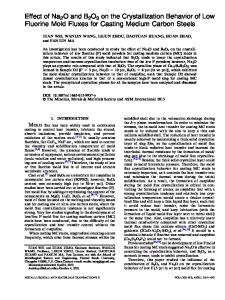Dynamic Wetting of High-Al Steel by CaO-SiO 2 - and CaO-Al 2 O 3 -Based Mold Fluxes
- PDF / 4,336,249 Bytes
- 11 Pages / 593.972 x 792 pts Page_size
- 92 Downloads / 322 Views
IN the initial solidification of steel, liquid mold fluxes could be entrapped by the meniscus hooks, causing slivers and blisters after subsequent rolling and annealing.[1,2] Liquid non-metallic inclusions may also spread over and react with solidifying steel, which results in surface imperfections.[3] Therefore, the wetting behavior of liquid mold fluxes is of great importance to the quality control in continuous casting of steel. Wetting behavior of mold fluxes on steel is closely related to the flux composition. Parry et al.[3] reported a higher interfacial tension between solid iron and CaO-Al2O3SiO2 slag than that in MnO-SiO2 system. Jung et al.[4,5] studied the interfacial tension between solid iron and CaO-SiO2-based slags. They found that the interfacial tensions decreased with the increases of Al2O3, FeO, and MnO contents due to the structural change of slags at high temperature. The effect of MnO on the interfacial tension and contact angles was confirmed by Wang et al.,[6] who also suggested that the increase of MnO content decreased both interfacial tension and contact
JIAN YANG, JIANQIANG ZHANG, and OLEG OSTROVSKI are with the School of Materials Science and Engineering, University of New South Wales, Sydney, NSW 2052, Australia. Contact e-mail: [email protected] YASUSHI SASAKI is with the Department of Metallurgy, Tohoku University, Sendai 980-8579, Japan. CHEN ZHANG and DEXIANG CAI are with the Baosteel Group Corporation Research Institute, Shanghai 201900, P.R. China. Manuscript submitted April 8, 2019.
METALLURGICAL AND MATERIALS TRANSACTIONS B
angles between CaO-SiO2-based mold fluxes and ultralow carbon steels. The increase of Al2O3/SiO2 ratio in the CaO-SiO2-Al2O3 system was found to increase the interfacial tension and contact angle when wetting interstitial free steel substrate, while the increase of CaO/SiO2 ratio showed an opposite effect.[7] The effect of TiO2 content on the wettability of a welding flux system was also examined.[8] As a recent research hotspot, the continuous casting of high-Al steel requires a careful attention to the wettability of steel by mold fluxes, which is greatly affected by the steel composition. The interfacial tension between liquid mold flux and high-Al steel is low since the reaction between [Al] from steel and SiO2 from the conventional mold fluxes leads to dynamical interfacial phenomena.[9,10] Most of the current investigations focus on the interaction between liquid metal and liquid slags. Riboud et al.[9] found that the reaction between liquid Fe-Al alloy and liquid CaO-SiO2-based slags lowered the interfacial tension drastically due to the mass transfer across the interface. Chung et al.[10] studied the interaction between liquid Fe-Al alloy and liquid SiO2-containing slags using X-ray photography. It was found that droplet flattening and spontaneous emulsification occurred due to the Marangoni and natural convections induced by the interfacial reaction. Few reports have addressed the dynamic wetting behavior of mold fluxes on solid steel substrates. Zhou et al.[11]
Data Loading...











